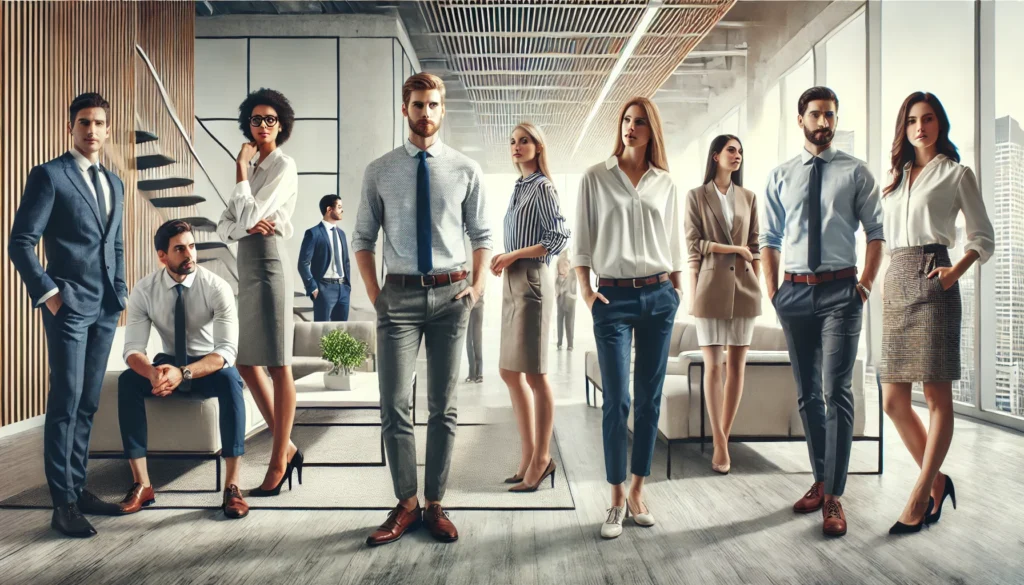Introduction
Business casual has evolved significantly over the years, transitioning from strictly adhering to formal business attire to a more relaxed yet polished wardrobe suitable for the modern workplace. This shift reflects broader changes in corporate culture, which increasingly values flexibility and individual expression alongside professionalism. As workplaces continue to diversify and dress codes become more varied, understanding the nuances of business casual is more crucial than ever. This article aims to demystify the elements of business casual attire, providing readers with the knowledge needed to navigate modern professional environments confidently and stylishly.
Understanding Business Casual
Business casual is a term that can perplex even the most fashion-savvy professionals, mainly because its definition can vary significantly depending on the context. At its core, business casual is a style that blends traditional business attire with a more relaxed, less formal aesthetic. For men, this might mean substituting a full suit and tie for a button-down shirt and chinos. For women, it could involve replacing a business suit with a bright blouse and tailored pants or a skirt. Business casual is about looking professional without the formality of traditional business wear, striking a balance that respects the workplace’s professional ambiance while allowing for personal comfort and expression.
Historical Perspective
The evolution of business casual attire can be traced back to the 1960s and 1970s, when the traditional corporate environment began to shift. The introduction of “Casual Fridays” in the 1990s marked a significant turning point, with companies allowing employees to wear more relaxed clothing at the end of the workweek. This trend was partly driven by the rise of industries such as technology, where comfort often took precedence over formality. Over time, these changes led to a redefinition of workplace attire, with business casual becoming a standard dress code that meets the demands of professionalism and modern comfort.
Elements of Business Casual
Men should focus on versatility and subtlety when assembling a business casual wardrobe. A selection of button-down shirts in neutral colors such as white, blue, or light pastel shades serves as a foundation. These can be paired with well-fitting chinos or wool trousers that maintain a professional look without the stiffness of suit pants. Shoes are equally important; leather loafers, brogues, or smart suede shoes can complement the outfit while providing comfort. The key is to ensure that each piece is in good repair and fits well, as sloppiness can detract from the professionalism Business Casual aims to convey.
Key Components for Women
For women, business casual encompasses various options tailored to individual style and workplace norms. Blouses and tops should balance modesty and femininity, avoiding overly casual t-shirts or any attire that might be too revealing. Trousers should be tailored but not tight, and skirts should typically fall just above or below the knee. Dresses can also be a fantastic business casual option, provided they are not too bright, short, or tight. Footwear should be comfortable but polished, with closed-toe flats, low heels, or bright boots being ideal.
Dressing for Different Business Occasions

For daily wear in a business casual environment, the goal is to look well-put-together without appearing overly formal. Men can opt for various shirt and trouser combinations, adding a lightweight sweater or a casual blazer if the situation calls for a slightly more dressed-up look. Women might choose a simple, elegant dress paired with a cardigan or a bright jacket, ensuring they are ready for any impromptu meetings or business lunches. The key to daily office wear is flexibility and ease, allowing seamless transitions between business activities.
Client Meetings and Presentations
When preparing for client meetings or presentations, it’s advisable to lean more toward the formal side of business casual. This might mean a blazer or a bright jacket over a tailored shirt for men and a sophisticated blouse paired with high-quality trousers or a pencil skirt for women. Accessories such as a fine watch, subtle jewelry, or a professional tote bag should be understated yet elegant. The aim is to convey confidence and competence through attire, enhancing one’s presence without overshadowing the professional interaction.
Company Events and Outings
Company events such as retreats, conferences, or casual dinners require a different approach to business casual. For these occasions, it’s appropriate to incorporate more personality into outfits—perhaps a brighter shirt for men or a stylish dress with unique details for women. However, the overall look should still align with the company’s culture and the event’s nature. Practicality is also crucial; consider the weather and venue for outdoor events when choosing shoes and outerwear.
Conclusion
Mastering business casual is not just about choosing the right clothes; it’s about understanding how to adapt one’s style to various professional settings. The key to success is balancing comfort with formality, ensuring that personal style respects and enhances the workplace’s professional standards. By embracing the versatility of business casual, modern professionals can navigate their careers with confidence and ease.
FAQs
What is considered too casual for business casual?
Typically, jeans, t-shirts, and overly casual footwear like sneakers or flip-flops are too casual for most business casual environments unless explicitly stated otherwise.
How often should I rotate my business casual wardrobe?
A seasonal rotation is recommended, with adjustments for wear and tear. Keeping the wardrobe fresh and updated can also maintain interest and appropriateness.
Can jeans be considered business casual?
In some creative or less formal industries, dark, well-fitting jeans might be acceptable as part of a business casual outfit. However, it’s best to follow specific company guidelines.
What are some quick tips to elevate a basic business casual outfit?
Adding a bright blazer, a high-quality watch, or a sleek leather bag can significantly enhance a basic business casual look.
How do cultural differences impact the definition of business casual around the world?
Business casual can vary significantly across different cultures and countries. Researching and respecting local customs and standards is essential when working internationally.
You May Also Read: https://usdigitaltime.com/tami-davidov-id-jewelry/
